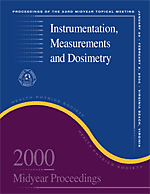
Instrumentation, Measurements and Electronic Dosimetry
Author: (HPS Midyear 2000)ISBN: 9780944838938 ISBN10: 0944838936
Published: 2000 | 271 pp | Softcover
Price: $ 35.95
Radiological Protection Bulletin | July/August 2000
“This is a fairly substantial collection of papers covering a wide range of subjects mostly by North American authors, but with some European contributors. The range covers nuclear and medical radiation protection, with some aspects of military practice.
“The quality and originality of the papers is variable, with the best ones mostly concerned with delicensing and site clearance applications, which is, after all, the only real growth area in instrumentation and measurement. The major reference in the field is the MARSSIM document, the Multi-Agency Radiation Survey and Site Investigation Manual, published as NUREG-1575. One paper, by Ceffalo et al, is particularly useful as it describes the practical application of the MARSSIM approach in the demolition of a large building. This leads to the free release of the demolition concrete debris with only a relatively limited measurement programme. Other papers cover the high sensitivity instrumentation needed for free release measurements on nuclear sites where it is often important to perform measurements over large areas using vehicle mounted equipment.
“Generally, position data are produced using GPS equipment but this has problems close to buildings and under dense tree cover. One paper, by Highfill, described on an apparently very effective ultrasonic-based system which would work in difficult conditions but also produce very accurate position data.
“Airborne measurements are frequently employed in mineral prospecting and can also be extremely useful after accidents leading to activity release and in tracking the deposition of routing releases. One problem which is routinely encountered is the influence of atmospheric radon progeny. Grasby described methods of calibrating airborne spectrometric equipment and ways in which the influence of airborne radon could be reduced.
“In summary, the proceedings are generally interesting but will prove most useful to those concerned with site clearance and delicensing.”
Peter Burgess
